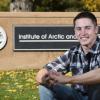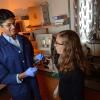Science & Technology
- <p>The University of Colorado Boulder Leeds School of Business will present its 48th annual Colorado Business Economic Outlook Forum on Monday, Dec. 3, at 1 p.m. at the Denver Marriott City Center.</p>
<p>The event at 1701 California St. is free and open to the public but reservations are required for those planning to attend. To make reservations visit <a href="http://leeds.qualtrics.com/SE/?SID=SV_01GMWmGLHZolUrz">http://leeds.qualtrics.com/SE/?SID=SV_01GMWmGLHZolUrz</a>.</p>  <p>A $20 million remote sensing instrument package built by the University of Colorado Boulder, which is leading a 2013 NASA mission to understand how Mars might have lost its atmosphere, has been delivered to Lockheed Martin in Littleton, Colo., for spacecraft integration.</p>
<p>A $20 million remote sensing instrument package built by the University of Colorado Boulder, which is leading a 2013 NASA mission to understand how Mars might have lost its atmosphere, has been delivered to Lockheed Martin in Littleton, Colo., for spacecraft integration.</p>- <p> </p>
<p>A $20 million remote sensing instrument package built by the University of Colorado Boulder, which is leading a 2013 NASA mission to understand how Mars might have lost its atmosphere, has been delivered to Lockheed Martin in Littleton, Colo., for spacecraft integration.</p> - <p>Some arid lands in the American West degraded by military exercises that date back to General George Patton’s Word War II maneuvers in the Mojave Desert should get a boost from an innovative research project led by the University of Colorado Boulder.</p>
- <p> </p>
<p>Students enrolled in the University of Colorado Boulder’s College of Arts and Sciences will soon be able to earn a Bachelor of Arts degree in computer science, following a vote today of the University of Colorado Board of Regents.</p>
<p>At present, CU-Boulder students seeking a degree in computer science must enroll in the College of Engineering and Applied Science, and if they also would like to study an arts and sciences discipline, they must complete a double degree.</p> - <p>Fire the coach? Not so fast says a new study of elite college football teams.</p>
<p>Professors from the University of Colorado and Loyola University Chicago studied what happened to the records of college football teams that replaced a head coach for performance reasons in the Football Bowl Subdivision (formerly Division 1-A) between 1997 and 2010. Over this period, an average of 10 percent of FBS teams fired their coach each year because of the team’s poor performance on the field.</p> - <p> </p>
<p>Analysis of 90 years of observational data has revealed that summer climates in regions across the globe are changing -- mostly, but not always, warming --according to a new study led by a scientist from the Cooperative Institute for Research in Environmental Sciences headquartered at the University of Colorado Boulder.</p>
<p>“It is the first time that we show on a local scale that there are significant changes in summer temperatures,” said lead author CIRES scientist Irina Mahlstein. “This result shows us that we are experiencing a new summer climate regime in some regions.”</p>  <p>Matthew Reed didn’t feel ready for college right out of high school. But after five years of military service, he felt more prepared to pursue a college degree.</p>
<p>Matthew Reed didn’t feel ready for college right out of high school. But after five years of military service, he felt more prepared to pursue a college degree.</p>
<p>“Being in the military made me disciplined,” said Reed. “I’m much better prepared and in a much better situation to be in college now.”</p>
<p>Reed, from Broken Arrow, Okla., is a sophomore majoring in geology and anthropology. Because he is an Iraq veteran, his tuition is covered by the Post 9/11 G.I. Bill.</p>- <p> </p>
<p>A new University of Colorado Boulder study shows for the first time that episodes of reduced precipitation in the southern Rocky Mountains, especially during the 2001-02 drought, greatly accelerated development of the mountain pine beetle epidemic.</p>  <p>Balaji Sridhar has always liked science, but it was his father’s bad knees that were the impetus for him to study both chemical engineering and medicine.</p>
<p>Balaji Sridhar has always liked science, but it was his father’s bad knees that were the impetus for him to study both chemical engineering and medicine.</p>
<p>His father once was a good squash player, but had to give up playing when the cartilage in his knees wore out. With the dual graduate degrees, Sridhar hopes to someday be able to help people like his father who struggle with debilitating joint pain and reduced mobility due to damaged cartilage.</p>


